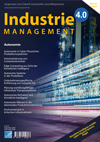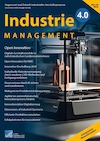Search


Bibtex
Cite as text
@Article{Gronau,
Year= "2018",
Number= "6",
Volume= "34",
Pages= "7-12",
Journal = "Industrie 4.0 Management",
Title= "Der angemessene Grad von Autonomie in Cyberphysischen Produktionssystemen",
Author= "Norbert {Gronau}",
Doi= "https://doi.org/10.30844/I40M_18-6_7-12",
Abstract= "Existierende Fabriken weisen häufig hierarchische Strukturen bei Entscheidungsfindung und Steuerung auf. Cyberphysische Systeme ermöglichen es prinzipiell, den Grad an Autonomie bei Entscheidungsfindung und Steuerung zu erhöhen. Unklar ist allerdings bisher weitgehend, bis zu welchem Grad Autonomie tatsächlich nützlich ist. Dieser Beitrag differenziert unterschiedliche Definitionen von Autonomie und Ansätze, diese zu erreichen. Erste experimentelle Erkenntnisse in einer Laborumgebung helfen, die aufgestellten Fragen zu beantworten. ",
Keywords= "Autonomie, Produktionssystem, Berechnungsverfahren, Cyber-physisches System, Simulation",
}
Norbert {Gronau}(2018): Der angemessene Grad von Autonomie in Cyberphysischen Produktionssystemen. 346(2018), S. 7-12. Online: https://doi.org/10.30844/I40M_18-6_7-12 (Abgerufen 21.10.24)
Open Access
Abstract
Abstract
Existierende Fabriken weisen häufig hierarchische Strukturen bei Entscheidungsfindung und Steuerung auf. Cyberphysische Systeme ermöglichen es prinzipiell, den Grad an Autonomie bei Entscheidungsfindung und Steuerung zu erhöhen. Unklar ist allerdings bisher weitgehend, bis zu welchem Grad Autonomie tatsächlich nützlich ist. Dieser Beitrag differenziert unterschiedliche Definitionen von Autonomie und Ansätze, diese zu erreichen. Erste experimentelle Erkenntnisse in einer Laborumgebung helfen, die aufgestellten Fragen zu beantworten.
Keywords
Schlüsselwörter
Autonomie, Produktionssystem, Berechnungsverfahren, Cyber-physisches System, Simulation
References
Referenzen
[1] ten Hompel, M.; Liekenbrock, D.: Autonome Objekte und selbst organisierende Systeme. Anwendung neuer Steuerungsmethoden in der Intralogistik. In: Industrie Management 21 (2005) 4, S. 15-18.
[2] Veigt, M.: Entwicklung eines Cyber-Physischen LogistiksystemS. In: Industrie Management 29 (2013) 1, S. 15-18.
[3] Gronau, N.: Der Einfluss von Cyber-Physical Systems auf die Gestaltung von Produktionssystemen, Industrie Management 31 (2015) 3, S. 16-20.
[4] acatech (ed.): Cyber-Physische Systeme. Innovationsmotor für Mobilität, Gesundheit, Energie und Produktion (acatech POSITION). Heidelberg 2011.
[5] Gronau, N.: Wandlungsfähigkeit in Produktion und Logistik, Productivity Management 2 (2014), S. 23-26.
[6] Gronau, N.; Theuer, H.: Determination of the optimal degree of autonomy in a cyber-physical production system. Procedia CIRP 57 (2016), S. 110-115.
[7] Gronau, N.: Determinants of an Appropriate Degree of Autonomy in a Cyber-physical Production System. Procedia CIRP 52 (2016), S. 1-5.
[8] Luck, M.; d’Inverno, M.: A Formal Framework for Agency and Autonomy. In: Procs First International Conference on Multi-Agent Systems. AAAI 1995.
[9] van der Vecht, B.: A Dynamic Coordination Mechanism Using Adjustable Autonomy. In: Sichman, J.; Noriega, P.; Padget, J.; Ossowski, S. (Hrsg): International Workshops on Coordination, Organizations, Institutions, and Norms in Agent Systems III, COIN 2007: COIN@AAMAS 2007 and COIN@MALLOW 2007, 3-4 September 2007, Durham., S. 83-96.
[10] Windt, K.: Autonomy in production logistics: Identification, characterization and application. Robot Comput Integr Manuf (2007), doi:10.1016/j.rcim.2007.07.008.
[11] Gronau, N.; Theuer, H.: Industrie 4.0 in Europa – Ein Vergleich Europäischer Initiativen In: Industrie Management 5 (2015), S. 31-34.
[12] Hülsmann, M.; Windt, K.: Understanding Autonomous Cooperation and Control in LogisticS. Berlin Heidelberg 2007.
[13] Scholz-Reiter, B., Görges, M., & Philipp, T. (2009). Autonomously controlled production systems — Influence of autonomous control level on logistic performance. CIRP annals 58.1 (2009): 395-398.
[14] Dashkovskiy et al. 2011: Modeling and stability analysis of autonomously controlled production networks. In: Logist. Res. (2011) 3:145–157 DOI 10.1007/s12159-011-0049-6
[15] Windt K, et al. Autonomy in production logistics: Identification, characterisation and application. Robot Comput Integr Manuf (2007), doi:10.1016/j.rcim.2007.07.008
[16] Armbruster, D., et al. “Autonomous control of production networks using a pheromone approach.” Physica A: Statistical Mechanics and its applications 363.1 (2006): 104-114.
[17] Karimi, Hamid Reza, Neil A. Duffie, and Sergey Dashkovskiy. “Local Capacity H∞ Control for Production Networks of Autonomous Work Systems With Time-Varying Delays.” IEEE Transactions on Automation Science and Engineering 7.4 (2010): 849-857.
[18] Caridi, M. & Cavalieri, S. (2004) Multi-agent systems in production planning and control: an overview, Production Planning and Control, 15:2, 106-118, DOI: 10.1080/ 09537280410001662556
[19] Theuer, H.; Gronau, N.; Lass, S.: The Impact of Autonomy on Lean Manufacturing SystemS. In: Proceedings of the 23rd International Conference on Flexible & Intelligent Manufacturing (FAIM 2013). Porto 2013.
[20] Rother, M.; Shook, J.: Learning to See: Value Stream Mapping to Add Value and Eliminate MUDA. Lean Enterprise Institute Cambridge 1999.
[21] Gronau, N.; Grum, M.; Bender, B.: Determining the optimal level of autonomy in cyber-physical production systemS. Industrial Informatics (INDIN), 2016 IEEE 14th International Conference on. IEEE 2016.
[22] Lass, S.; Theuer, H.; Gronau, N.: A New Approach for Simulation and Modeling of Autonomous Production ProcesseS. In: Proceedings of the 45th Hawaii International Conference on System Sciences (HICSS 2012). Maui, Hawaii 2012.
[23] Gronau, N.; Theuer, H.; Lass, S.: Evaluation of Production Processes using Hybrid Simulation. In: Windt, K. (Hrsg): Robust Manufacturing Control, Lecture Notes in Production Engineering. Berlin Heidelberg 2013.
[24] Lass, S.: Simulationskonzept zur Nutzenvalidierung cyber-physischer Systeme in komplexen Fabrikumgebungen. PhD thesis Potsdam University 2017.

 English
English